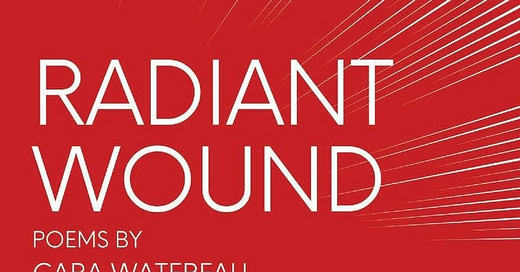Cara Waterfall, Radiant Wound. Unsolicited Press, 2025.
Review by Emily Osborne
In the last twenty years, there has been a notable increase in the number of journalist poets, writing a variety of “poetry of witness.” These journalist poets are mostly women and include acclaimed writers such as Eliza Griswold, Gillian Conoley, Alissa Quart, Carolyn D. Wright, Michelle Porter, and Monika Kidd. Recent articles have considered affinities between journalism and poetry as affective writing forms, and have countered long-held attitudes presupposing that journalism and poetry occupy polar locations on the spectrum of “objective” and “subjective” writing. Several journalist poets have themselves written about generic affinities between journalism and poetry, generally focusing on how both genres deal in truths, and how they bear witness through precise language to details casual observers might miss. More scholarship, I suspect, will soon be published on “emerging conventions” (if I may speak paradoxically) of journalistic poetry. With an eye towards expanding this area of discussion, I would like to review the multitextured, journalistic poetry debut Radiant Wound by Cara Waterfall.
Radiant Wound bears witness to the aftermath of the Second Ivorian Civil War (2010-2011). Waterfall (a French-speaking Anglophone who was born in Ottawa) currently lives in Abidjan. She began composing the poems in Radiant Wound a decade ago: after studying at the London School of Journalism, Waterfall relocated to Côte d’Ivoire and received a fund from the National Geographic Society to write about the resilience of the country’s women after war. Many of the poems in Radiant Wound feature these remarkable women, but they also give a broader view of the post-war culture and of Waterfall’s own admiration for the citizens and culture of a place where she now resides. Waterfall’s poetic vision is expansive and particular, ranging from the Prime Minister’s palace and cityscapes to an abandoned helicopter skeleton and the baby on the back of a woman grilling in a maquis. This vision also challenges us repeatedly to look carefully at atrocities. The dehydrated lioness in the zoo commands the other lions (and by extension the reader): “See me ever as your retinas tear like the savane’s summer grasses”. Bodies become a pulpy mass, the crocodile caretaker is eaten by the animals he tends, and animals starve in zoos, birthing verse which is incomplete testament:
melancholy pervades
like tear gas /
aged trees sag / each cage
is an unfinished stanzaIn refusing to look away and in foregrounding surprising detail, Waterfall’s poems are punctuated with a photographic quality, much as journalism is enlivened by photographs. Many “still life” poems stun with a terrible and visualizable beauty, such as in “Still Life with Animals”:
the Iroko trees are cadavers
& at dusk / they are rubied
like hacked tusks
the antiqued eyes / of rifles
flame / between branches Or, in “Ode to Rust,” the abandoned helicopter chassis is both human and inanimate, addressed in its prone state:
your cockpit is a riven cranium
its jaws sutured by wire
its tail boom dislocated,
rudder bent like a knee in the dirtThe chicken carver, too, leaves an indelible impression, sitting still as “dawn saws through a scrapyard” until he makes his cut like the arriving dawn and “threshes a tremor of feathers & shirrs / the fleecy chest gouges the lithe hollow of the throat”. Journalistic poetry looks directly and minutely, but also uncovers truth by viewing askance through symbolism, finding the human, animal, botanical, and mechanical superimposed as victims in war’s carnage.
Journalistic poetry sees by mediating assumed distances amongst subject, author, and reader: as in journalism, an arena unfamiliar to the writer has been entered, however, as in poetry, this observed subject has acquired a greater degree of intimacy. And yet, the journalistic poet must maintain a necessary distance, lest they be deemed a “disaster tourist.” Waterfall frequently returns to this theme of assumed distance in her roles as journalist and poet. Near the book’s start, the narrator is lifted above the city on a plane, a witness with distance who both calls Abidjan home and who does not claim the trauma of the place. This distance is frequently worked out in Waterfall’s poems, and in other journalistic poetry, through critiquing the structures and failures of poetic language. The starving zoo lions lament that they are left to feed on “the syllables of / birds, in this citadel we would never leave”—here, the aural overlap of “syllable” and “citadel” underscores language’s lack of sustenance and substance. So too, “Ode to Two Hyenas” examines what can and cannot be understood through human-animal communication, as Latinate words butt up against glottal back sounds:
don’t forget the growling
vowels & timbre
of their almost-syllables.
A cackle has its glossary
for survival, their argot
supports their bravado.In “Grand Bassam Saudade,” a poem for the victims of the Grand-Bassam terrorist attack, the narrator confronts the near-inability to speak of such tragedy, remarking that silence “keeps / the unsayable intact / needled together”. Finally, the narrator asks:
how do I helm this ship home
when the last hymn
I hear is the sea’s
metal slurry?In these four lines, the alliteration of “h” and repetition of single-syllable words has an incantatory quality, the almost-ineffable then slammed by the trochaic “metal slurry” of an ocean’s worth of trauma. In “Linguistics,” Waterfall crafts rich tension. Internal rhyme, assonance, and careful rhythm patterns stitch words together, while increasing white space pulls them apart:
out slips sideways the jabber
of translation
threadbare
(…)
in this impossible drought,
tongue fattens
& declares
mutiny
upon itself
(…)
speech like pulling teeth
leaves stumps
red
embedding meWaterfall has deftly produced “a map of sounds / that is hungry / to expand its geography” yet which acknowledges the limits of the task for someone who is a cultural and linguistic outsider.
Radiant Wound is intensely and persuasively preoccupied with this issue of what poetry can and cannot say about human-inflicted horrors. Perhaps unsurprisingly, an “I-voice” is rare in the poems and people speak only rarely. When they do, Waterfall is careful not to put words into her subjects’ mouths, for example mediating this distance through ekphrasis on Ivorian citizens’ own art. In “Red Canvas”, Waterfall includes a direct quotation from the artist Yubah Sanogo to preface the poem: “I was painting and blood spattered onto my canvas. A bullet had grazed a woman who was running with her child. I left the wound to say ‘never again’”. The first-person poem which follows is clearly inspired by Sanogo’s words, but does not attempt to speak for him. It is a panoptic artistic vision which sees the sky, carrion beetles underfoot, a rooster on a roof and men running with dead bodies. It is a visionary voice which “cannot unsee”. Similarly, the poem “Sissi Barra: The Way of Smoke” is based on a series by acclaimed photographer Joana Choumali, who captured the charcoal-gatherers’ work. Waterfall’s poem adopts its I-voice only through the lens of Choumali’s intimate photographs: “I was born in the Bardot dust. I played in sawdust squalls, and on scabbed logs crisscrossing / the sewage […] My half-winged daughter, I invoke / the smoke to accompany you”.
Radiant Wound is an uncommon reading experience: many of its poems devastate even as they delight through verse which is sonorous and richly symbolic. There were points where I had to stop reading and bury my face in my hands, and points where I was compelled to recite aloud to relish the bewitching internal rhymes and assonance of verse which “monsters forth its orphan chant”. The book’s concluding poems, which celebrate the beauty and resilience of the land and people of Côte d’Ivoire, come as pure joy. Here we find a definition of “Evening” that begins predictably as “the latter part of day” and rises to universal and tangible beauty:
when the aftertaste
in the air is citronella & smog / when the musk from your
body / rises / warm & unmistakeable / a scent swarming
everywhere / holding everything aloft / even the vagrant stars”The collection’s final poem, “Fat Ode,” admires wooden carvings of female bodies, and it invites the reader in by employing the intertextual structure of an “O antiphon”:
O blessed
be the prose of wood that blooms
the body’s rose
[…]
O abundant
ballad of the rounded belly
& canticle of thick ankles
[…]
O wondrous
contralto of robust goddesses, plucking
joy from the lyric darkEach syllable of this “wondrous contralto of robust goddesses” loops back, expertly mimicking its rounded subjects and the perfection of their forms. This ode sings more brightly against the “orphan chant,” in its keen awareness that beauty can be harvested from the “lyric dark.”
Emily Osborne’s poetry, fiction, and translations are published in The Paris Review, The Fiddlehead, The Malahat Review, The Windhover and elsewhere. Her books include THE SKALDS (W. W. Norton, 2026/2027) and Safety Razor (Gordon Hill Press, 2023). Emily has a PhD in Old Norse Literature from the University of Cambridge.






This review is a compelling argument to read more journalistic poetry, especially in a politically charged world where discourse is often too antagonistic to recognize the destruction and human suffering at the heart of these events. However, the lens of the poet is careful not to exploit. The journalist never becomes a voyeur.
“Journalistic poetry sees by mediating assumed distances amongst subject, author, and reader: as in journalism, an arena unfamiliar to the writer has been entered, however, as in poetry, this observed subject has acquired a greater degree of intimacy. And yet, the journalistic poet must maintain a necessary distance, lest they be deemed a ‘disaster tourist.’ “
Emily, thank you for your thoughtful and nuanced review of RADIANT WOUND in @LitMagReview. I am so moved by how you illuminated the ways reportage and verse can amplify each other's power. Thank you for engaging so deeply with these poems and their origin stories!